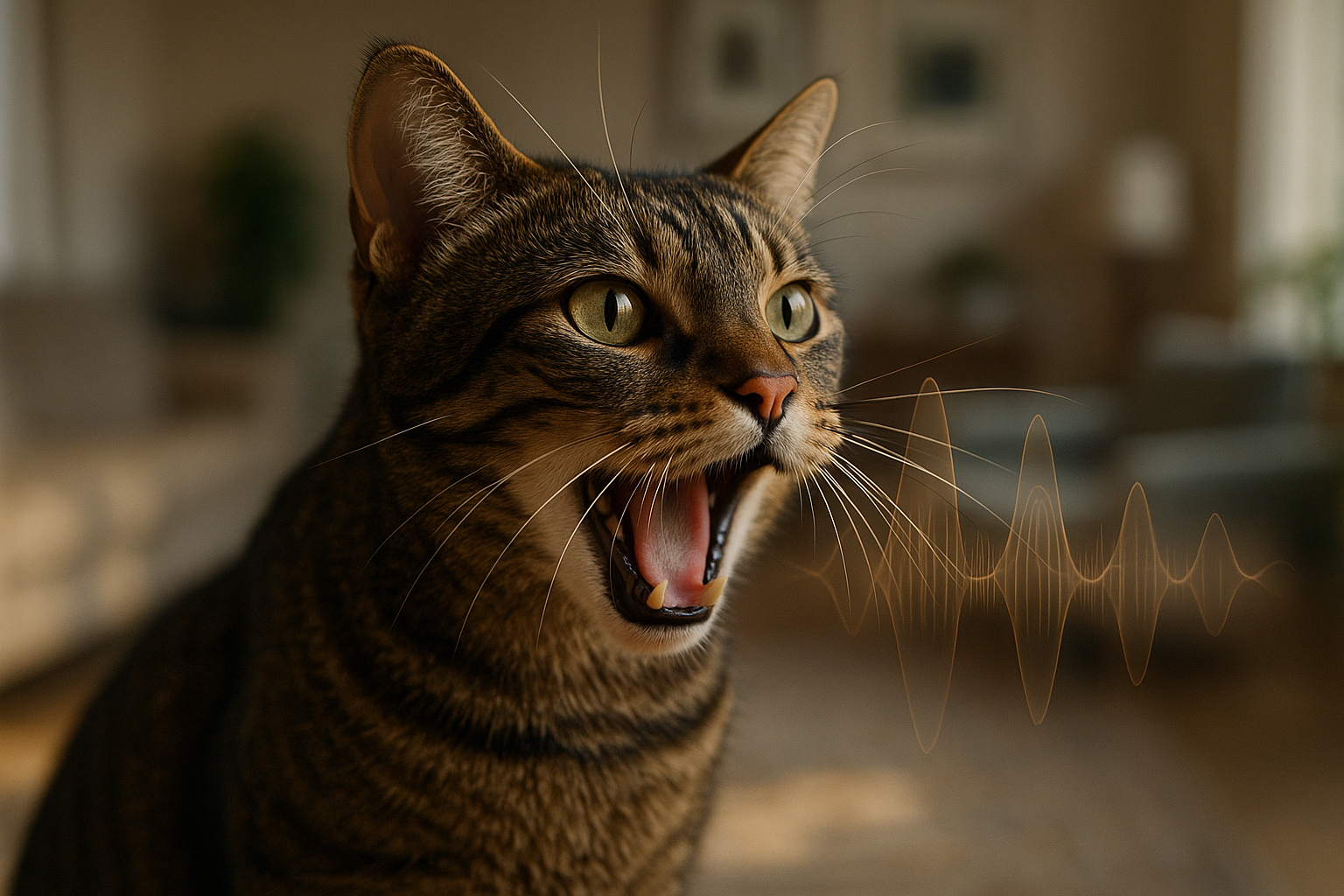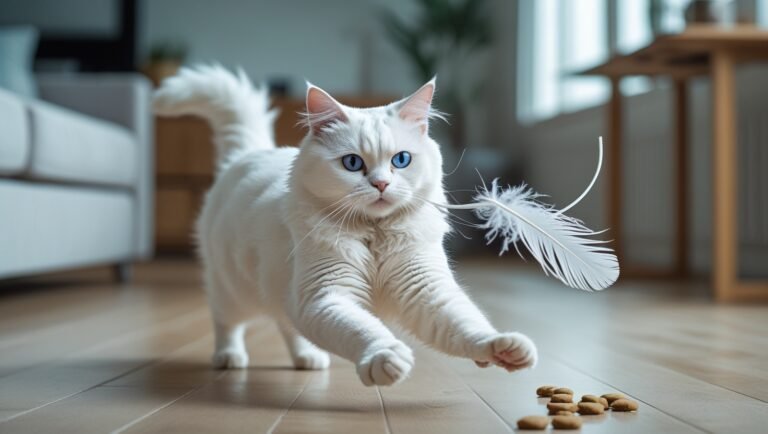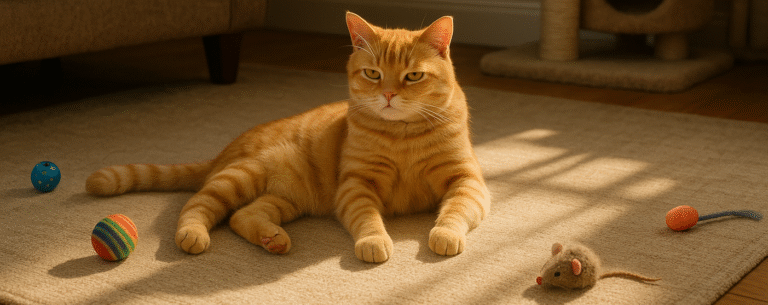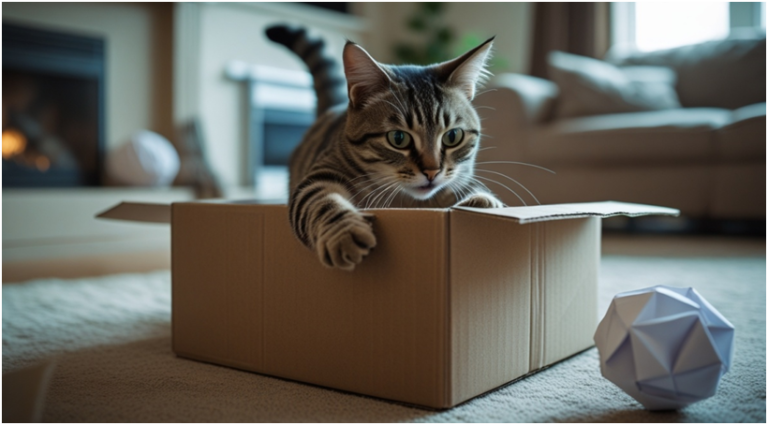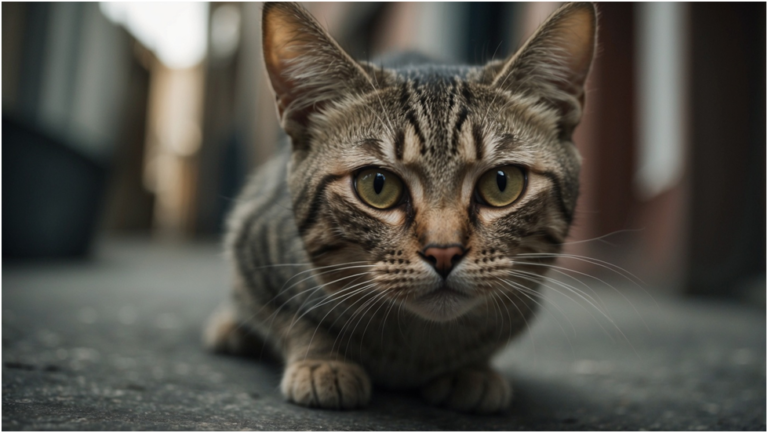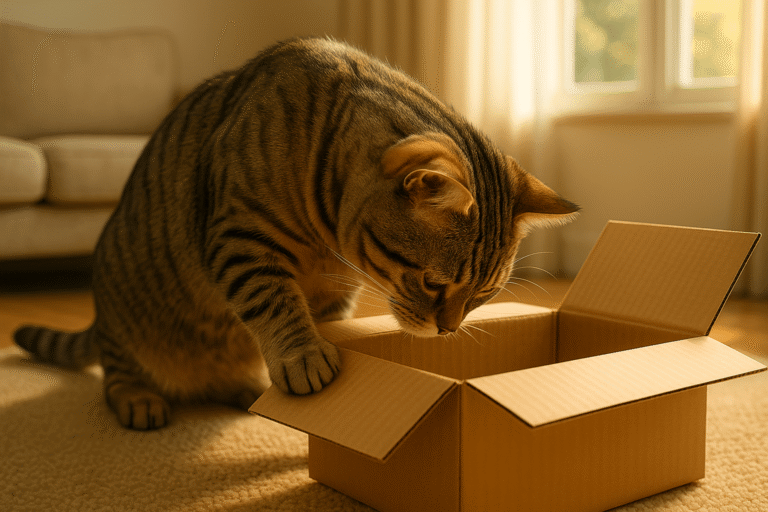Decode Your Cat Vocalizations : Meow Meanings & Communication Tips
Welcome, dedicated cat parent! You share your life with a fascinating feline friend, a creature of mystery and charm. One of the most captivating aspects of our furry friends is their unique communication style, especially diverse range of cat vocalizations. From the softest purr to the most insistent yowl, your feline companion is constantly talking to you. But what are they really saying? Understanding the language of cats, a powerful form of vocal communication, can transform your relationship, turning confusion into connection.

Close-up of domestic cat meowing with mouth open showing communication behavior and cat vocalization
Our feline companions possess an impressive vocal repertoire, perhaps one of the widest among carnivores, according to research highlighted by CAB International and studies published via PMC NCBI . This complex system of cat sounds wasn’t just developed for chatting with other cats; a significant portion of it evolved specifically to communicate with their human companions. This article will delve deep into feline communication, helping you interpret the symphony of common sounds and distinct sounds your cat produces, from a simple meow to more complex types of vocalization. We’ll also explore how body language, including facial expressions, body posture, and tail behaviors, plays a crucial role alongside these sounds.
Many pet parents ask, “Do cats develop unique ‘accents’ or words?” It’s a great question! While they don’t form words like humans, cats absolutely develop a personalized communication style. Studies, some discussed in resources like Applied Animal Behaviour Science and even noted by institutions such as Lund University in their research on animal communication, show that adult cats can modify their cat meows based on their interactions with humans. Some research indicates that humans can, with experience, identify the context of different types of meows . So, that special cat meow your feline friend reserves just for you? It’s a testament to your unique bond and their adaptive communication in cats.
Let’s embark on this journey to better understand your cat’s vocal repertoire and what each chirp, trill, and classic meow truly means.
The Meow: More Than Just a Greeting
The cat meow is perhaps the most iconic of cat sounds, but it’s far from a simple meow. Interestingly, adult cats rarely meow at each other; this form of communication is largely reserved for their human counterparts. Research, including studies accessible through PMC NCBI, indicates that a staggering 81% of cat meows are directed at humans . This makes you wonder, “Why do feral cats rarely meow compared to house cats?” The answer lies in domestication. Feral cats, relying on stealth, find extensive vocal communication a liability. House cats, however, have learned that meowing is an effective way to get attention from their human companions.
The types of meows are incredibly varied. High-pitched meows (often ≥800 Hz) are frequently urgent requests, perhaps for food or to be let outside.
Some researchers suggest these high-pitched meows cleverly mimic the frequency of human infant cries (around 300–600 Hz), effectively tapping into our innate caregiving responses . So, if you’ve ever felt an irresistible urge to respond to one of those sharp, pleading cat meows, you’re not alone!
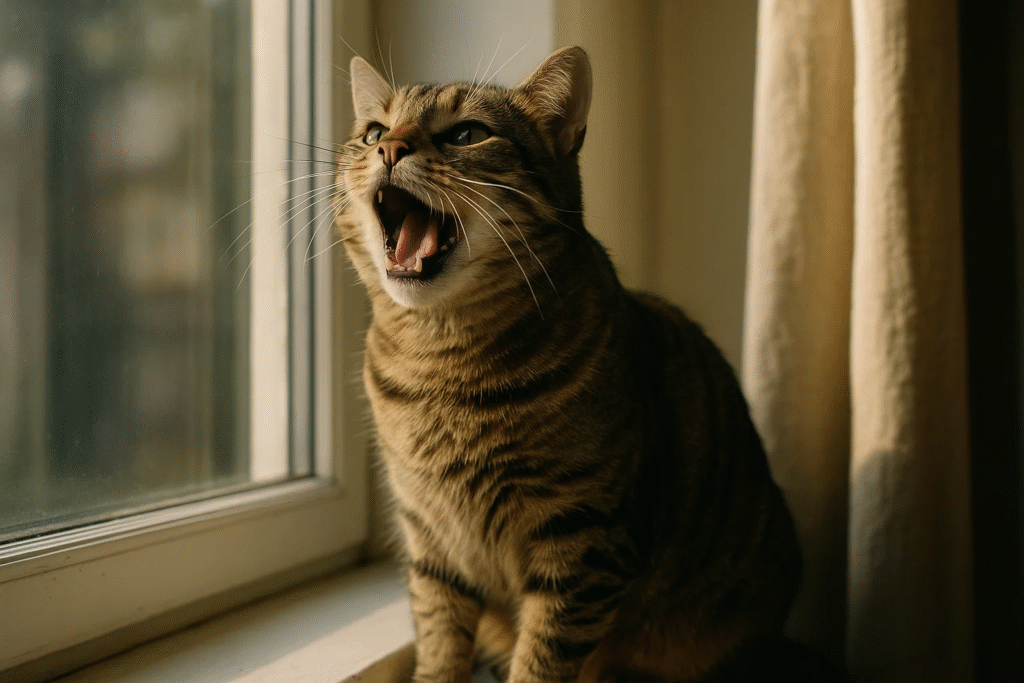
Tabby cat meowing on windowsill demonstrating typical feline vocal communication and cat behavior
A mid-range, often melodic meow, can be a friendly greeting or a general bid for attention. Then there are Loud Meows, or a loud, drawn-out meow, which usually means your furry friend wants something specific, and they want it now . Conversely, a soft meow might be a gentle reminder or a subtle plea. But what if the meow sounds hoarse, sometimes dubbed a “smoker’s meow”? This could indicate a health issue. As a cat parent, it’s wise to note that such changes can signal laryngeal irritation or even more serious respiratory problems, especially since cats in households with smokers face increased risks.
A 2023 study highlighted by PMC NCBI using AI analysis revealed that cats even modify the “jitter” or voice instability in their meows when stressed, creating a “creaky” sound that humans perceive as more urgent. And what about the “silent meow”—that endearing moment when your cat opens its mouth as if to meow, but no sound comes out? This is a fascinating type of vocalization. Far from being a sign of a problem, it’s often an affectionate, attention-seeking gesture observed by about 50% of pet parents in positive contexts.
Purring: The Multi-Faceted Vibration
The purr is often seen as the ultimate sign of contentment, a clear sign of happiness in our feline companions. While this is frequently true, the science behind purring, as detailed in various veterinary resources and studies available through CAB International, reveals a more complex picture. Yes, a cat purring contentedly on your lap (often at 25-30 Hz) is likely a very happy feline friend. But what about other contexts? How can you tell if your cat’s purr means happiness or pain?
Cats also purr when they are anxious, injured, or even dying. This “stress purr” often has a slightly different quality, perhaps more irregular and at a lower frequency (around 18-22 Hz). The vibrations produced during purring, particularly in the 35-50 Hz range, are thought to have therapeutic effects, promoting bone growth and healing—a remarkable built-in first-aid kit! Kittens purr while nursing, which is believed to not only signal contentment but also potentially stimulate the mother’s milk flow. The mother cat may also purr to reassure her kittens .

Content siamese cat purring on human lap showing relaxed feline body language and bonding behavior
A 2022 accelerometer study found that cats purr 14% longer when in physical contact with their owners, emphasizing the social bonding aspect of this unique type of vocalization . So, while purring is often a sign of affection and a sign of trust, always consider the context and your cat’s overall body language and facial expressions.
Trills & Chirps: The Friendly Fanfare
Beyond meows and purrs, cats have a delightful range of sounds including trills and chirps. If you’ve ever wondered, “Why does my cat trill or chirp instead of meowing?”, you’re noticing a very special form of communication. The trill, a rolling “brrrrt” sound (around 454.92 Hz, 56.58 dB according to some acoustic analyses ), is typically a friendly greeting or an expression of excitement. A study involving 74 cats, published in a PMC NCBI article, found that 89% of cats trilled during play sessions, while none did so in aversive situations . This type of vocalization is often used when they greet you or anticipate something pleasant, like a meal.
Is your cat’s trilling a leftover behavior from kittenhood? Absolutely. Mother cats use trills to call and guide their kittens, and many adult cats retain this endearing sound as a sign of affection or a way to initiate positive interactions with their human companions and other friendly felines . If your cat trills when you touch them, it’s generally a happy acknowledgment. Some pet parents also describe an “activation sound”—that quick trill when a cat is startled awake. This usually signifies mild surprise rather than fear or aggression. About 75% of owners report this “prrbt” noise when their cats are touched or woken

Black cat making trilling sounds at window while watching birds showing excited feline vocalization
The chirp, or “tweet vocalization,” is another fascinating sound, often heard when your feline friend is watching birds or squirrels through a window. This sound, sometimes accompanied by chattering teeth, is thought to be an expression of excitement, frustration, or an imitation of prey sounds.
The Nighttime Yowl & Other Urgent Calls: When to Worry
That 3 AM serenade from your feline companion can be perplexing. Why does your cat yowl at 3 AM? Several factors can contribute. Younger cats might simply have pent-up energy. For older cats, however, excessive meowing or yowling, especially at night, can be a red flag. Studies, like one discussed by PMC NCBI focusing on Cognitive Dysfunction Syndrome (CDS) in elderly cats, reveal that up to 40% of cats over 11 years old exhibit increased nighttime vocalization often linked to cognitive dysfunction or an underlying health issue like hyperthyroidism or hypertension .
So, is non-stop meowing, or persistent meowing, always a sign of pain or cognitive dysfunction? Not always, but it warrants investigation. In cats diagnosed with CDS, owners reported that 64.8% of the time, they believed confusion was the cause of increased vocalization, while pain was perceived as the cause in only 2.7% of cases . However, if there’s a sudden change or increase in any type of vocalization, especially Loud Meows or distressed calls, a vet visit is crucial to rule out health issues or mating issues (if unneutered).
What about other urgent sounds? Defensive sounds like hisses and growls are clear indicators of fear or displeasure. The hiss sound, an explosive release of air, is an unmistakable warning. Growls, deeper and more rumbling, often precede more aggressive behaviors. These are not sounds to ignore; they signal your cat feels threatened. Understanding these vocal cues, along with their body language – such as a puffed-up tail, flattened ears, or an arched back – is vital for preventing escalation.
Body Language: The Silent Counterpart to Vocalizations
Feline communication is rarely just about sound. Our furry companions are masters of multimodal communication, where vocalizations are often accompanied by telling body language. As a cat parent, learning to read these body signals alongside the sounds will give you a much fuller picture of what your feline friend is trying to convey.
Facial expressions in cats can be subtle. Dilated pupils might indicate fear, excitement, or arousal, while narrowed pupils can signal aggression or intense focus. The position of the ears is also very telling: ears pricked forward show alertness and interest, while ears flattened back against the head are a clear sign of fear or anger. Even whisker position changes with mood!
Body posture provides a wealth of information. A cat arching its back with fur standing on end (piloerection), often presenting a sideways stance, is trying to look bigger and more threatening – a classic defensive display. Conversely, a cat rolling over to expose its belly might be showing a sign of trust and relaxation (though be cautious, as some cats do this as a defensive C.A.T. action – Cease All Threatening-actions).
Tail behaviors are a particularly expressive part of cat language. An upright tail or tail erect, perhaps with a slight curve at the tip, is generally a friendly greeting and a sign of happiness. A tail held low or tucked between the legs often indicates insecurity or fear. A rapidly twitching or thumping tail can signal irritation or impending aggression, while a puffed-up tail is a definite sign of aggression or extreme fear . Observing these visual cues alongside the wide range of cat vocalizations is key to truly understanding your pet. A study highlighted by PMC NCBI on multimodal communication noted that cats displayed more tail wagging in response to vocal communication compared to bimodal (vocal and visual) communication in interactions with unfamiliar humans, suggesting the complexity of how they process different cues .
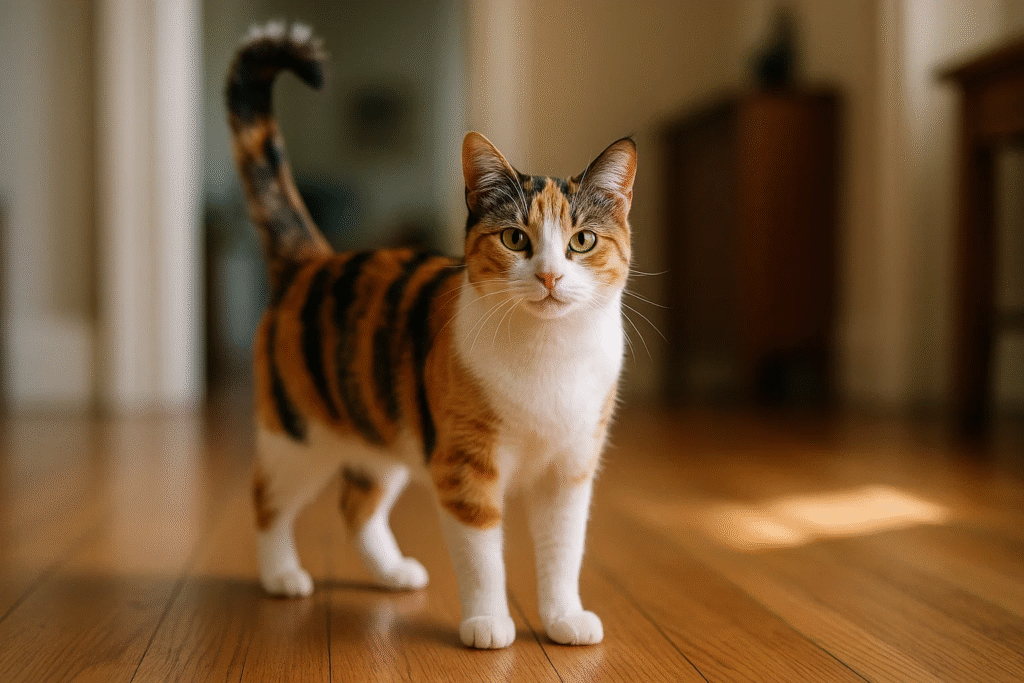
Calico cat with tail up displaying confident body language and positive feline communication signals
Deciphering Specific Scenarios & Sounds
Let’s address some common questions pet parents have about their cats’ vocal repertoire:
“Why does my cat growl at fluffy toys but not smooth ones?” This is often linked to predatory instinct. The texture of a fluffy toy might more closely mimic actual prey, triggering a possessive or “kill” growl. Around 70% of owners report this type of play-growling, which is usually harmless unless it escalates to genuine aggression.
“How do I interpret ‘angry’ vs. ‘playful’ meows during roughhousing?” This can be tricky! Generally, playful cat meows are shorter and may have a higher pitch, accompanied by “play” body language (bouncy movements, relaxed body posture). An angry meow is often lower, more drawn-out, and frequently paired with growls, hisses, or tense body signals like a puffed-up tail.
“Why does my cat chatter at birds but not toys?” That fascinating chattering or “tweet vocalization” you hear when your cat is birdwatching is a unique sound. About 80% of cats exhibit this behavior when seeing inaccessible prey, like birds through a window. It’s thought to be a sign of excitement, frustration, or even a thwarted hunting instinct. Toys, even if prey-like, often don’t elicit the same intense response because the “unreachable” element is missing.
Environmental & Social Influences on Feline Vocalizations
The environment your feline friend lives in, and their social interactions, significantly shape their communication style and the range of vocalizations they use. Indoor cats living in apartments, for example, may vocalize up to 2.3 times more than cats with outdoor access, potentially due to boredom or seeking more interaction from their human companions. Studies have shown urban cats might produce around 42 daily sounds versus 28 for rural cats, with a higher percentage of these being stress-related vocalizations in urban settings (34% vs 12%) .
Are deaf cats more vocal? Yes, often they are. Research from institutions like Seoul National University or studies published by sources like Cambridge University Press indicates that deaf cats may vocalize more loudly and frequently. This is because they lack auditory feedback to modulate their own volume. Their vocalizations might also have a different pitch and less variability compared to hearing cats .
In multi-cat households, an interesting dynamic emerges. About 55% of cats in such homes may develop unique “dialects” or modify their vocal communication to navigate social hierarchies and avoid conflict. You might notice lower-ranking cats using more high-pitched meows, while dominant cats may favor different tones.
Breed can also play a role. Are you a cat parent to a Siamese or perhaps a Maine Coon or Russian Blue? You might have noticed differences. For instance, “Do Siamese cats really ‘talk’ more than other breeds?” Generally, yes. Over 90% of Siamese owners describe their cats as exceptionally “talkative,” utilizing a wide range of cat meows and other distinct sounds to communicate their desires. This is partly due to genetic predisposition and selective breeding for these vocal traits.
Health Red Flags in Vocal Changes
A sudden change in your cat’s vocal repertoire or the frequency of their common vocalizations can be one of the first physical signs of an underlying health issue. As a responsible cat parent, it’s crucial to be attuned to these shifts.
For senior feline companions (those over 12 years), specific vocal changes can be telling:
- Four or more nighttime vocal episodes per week could indicate an 89% chance of hypertension.
- Persistent high-pitched meows (over 1000 Hz) have shown a 67% correlation with hyperthyroidism.
- A shift to more monotone vocalizations has been linked 54% of the time to dementia or cognitive dysfunction.
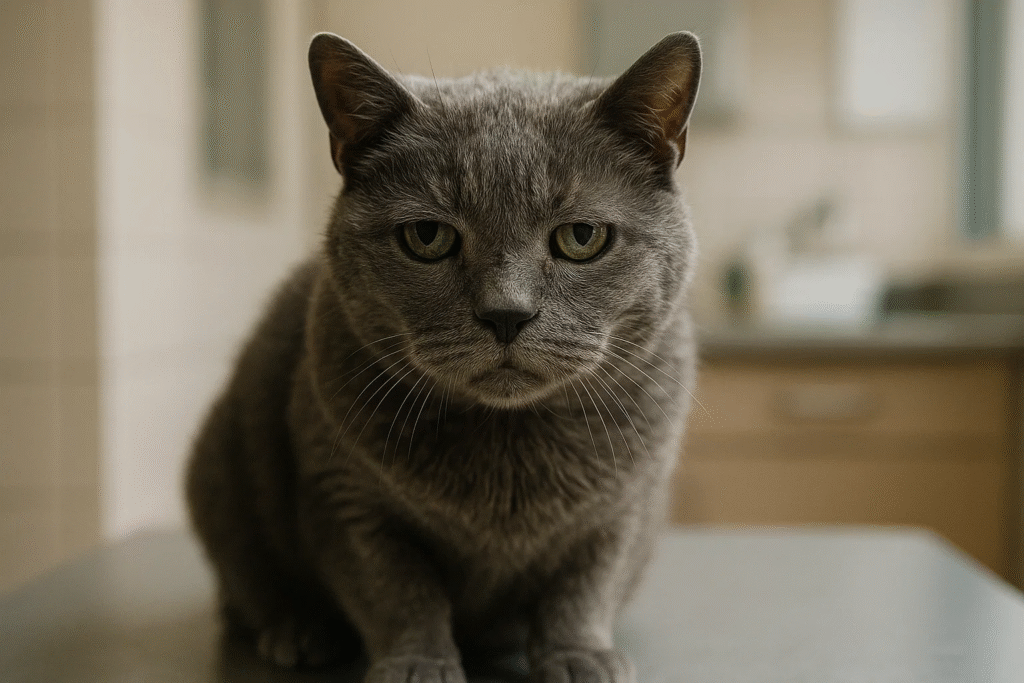
Senior gray cat showing age-related changes in feline behavior and health considerations for older cats
While around 40% of owners might report excessive meowing as a concern, it’s also important to note what isn’t heard. Video studies have revealed that about 71% of cats may communicate pain through “silent meows”—the mouth moves, but little or no sound emerges. Furthermore, 62% of urinary tract health issues might first show subtle signs like changed vocalizations in or around the litter box.
Actionable Tips: Becoming a Better Listener to Your Feline Friend
Understanding cat language is an ongoing journey. Here are some tips, backed by observations and studies, to help you become an even better listener and respondent to your furry friend:
- The 3-Second Response Rule: Cats often expect a response (even a verbal one from you) within about 3 seconds of vocalizing. Research suggests delayed responses can increase follow-up meows by as much as 300% as they try harder to get your attention.
- Mealtime Meows: If you’re dealing with persistent meowing for food, consider how you feed your cat. Cats fed smaller, more frequent meals (e.g., 4 times a day) have shown a 41% reduction in “demand” cat meows and a 22% increase in happy trills. Many pet parents ask, “How do I stop my cat from meowing for food constantly?” Behavioral training is key: wait for a moment of quiet before providing food, thus rewarding the silence, not the excessive meowing. About 70% of owners see success with this consistency.
- Play is Powerful: Just 10-15 minutes of interactive play (like with a feather wand) can reduce stress-related cat vocalizations by up to 57% and increase positive sounds like chirps by 33%.
- Vocal Matching: Some studies suggest that trying to imitate your cat’s meows (at about 83-92% of their original pitch) can strengthen your bond by up to 40% and reduce anxiety-related sounds by 29%. It’s a form of communication they might understand as an attempt to connect.
- Observe Body Language and Facial Expressions: Always interpret cat vocalizations in context. A soft meow with a slow blink and relaxed body posture is very different from a soft meow from a cat cowering with flattened ears. Direct eye contact can be tricky; a hard stare is often a challenge, while slow blinks are a sign of trust and affection.
- Cross-Species Chats: “Can cats communicate with dogs through vocalizations?” In multi-pet households, about 60% of owners report a degree of understanding. While their “languages” differ, common signals like growls (warning) or trills (play invitation from a cat) can be recognized.
The Future of Feline Communication: Tech to the Rescue?
The quest to understand our feline companions better is leading to exciting technological advancements. Many pet parents are curious about AI-powered apps. “Can AI apps like MeowTalk accurately translate cat sounds?” While apps like MeowTalk claim up to 79% accuracy in detecting the context of common vocalizations (and even claim 91% accuracy for detecting pain in some newer algorithms), user experiences vary. They can be helpful for identifying basic needs but may struggle with the more nuanced emotional states reflected in the symphony of sounds our cats make.
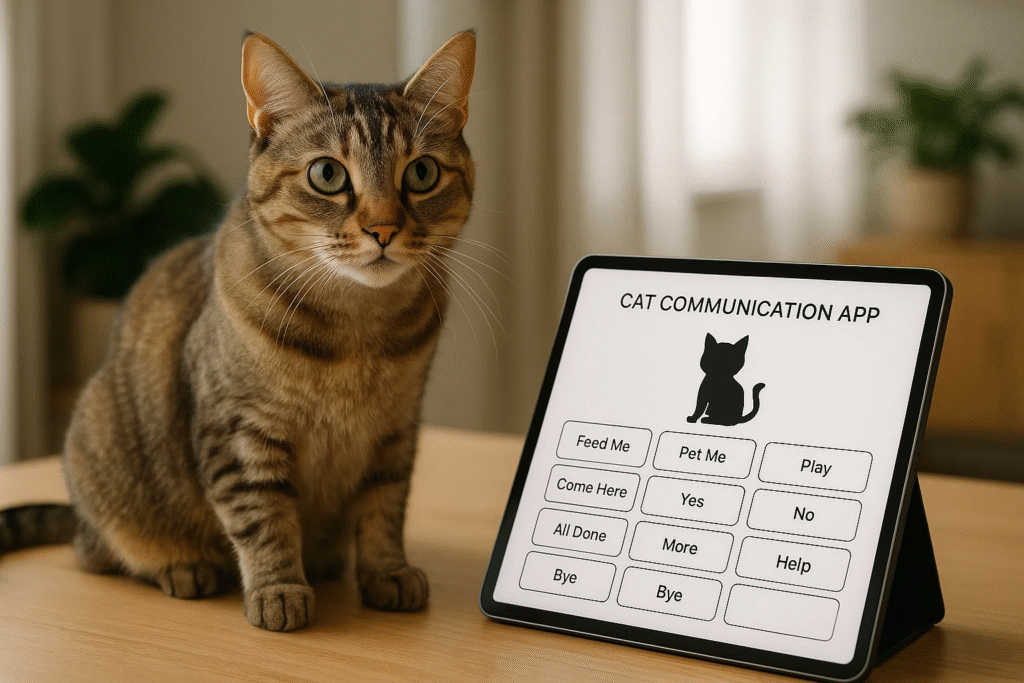
Modern cat with smartphone displaying pet communication app showing technology for understanding feline behavior
Other emerging technologies include collars that emit specific low-frequency pulses (around 25 Hz), which some studies suggest can reduce unwanted cat meows by up to 63%. Even more futuristic are cross-species EMG (electromyography) sensors being researched, which aim to predict cat vocalizations fractions of a second before the sound is even produced! These tools, often highlighted in publications focusing on animal welfare technology (some research may be found via CAB International or in bioacoustics journals , promise a deeper understanding, but human intuition and careful observation of your feline friend’s unique communication style remain invaluable.
Conclusion: Strengthening Your Bond Through Understanding
Decoding the rich vocal repertoire of your feline friend is more than an academic exercise; it’s a pathway to a deeper, more fulfilling relationship. Every type of vocalization, from the subtlest soft meow to the most demanding loud meow, combined with their expressive body language and facial expressions, offers a glimpse into their world. As a cat parent, recognizing that excessive meowing might signal an underlying health issue, or that a purr isn’t always a sign of contentment, empowers you to provide better care.
The language of cats is a dynamic and adaptive form of communication, constantly evolving in response to their human companions. By paying close attention to their wide range of cat vocalizations, their tail behaviors, and other body signals, you’re not just deciphering common sounds; you’re honoring the sophisticated communication style of your furry friend. This journey of understanding fosters greater empathy, strengthens your bond, and ultimately, makes you an even better pet parent to your cherished feline companion.

